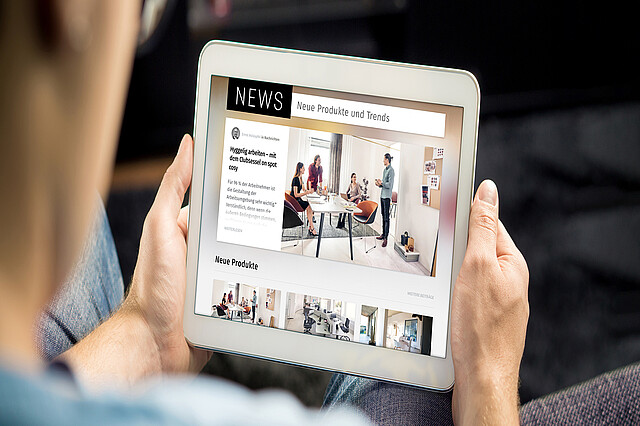Companies need to design their offices in such a way that they offer attractive advantages over other places of work. The office should function as the “centre” of a hybrid work ecosystem that serves the various needs of employees and at the same time promotes collaborative processes. Three key questions are at the forefront here:
- The right size of office: How to find the optimal office space when employees have the freedom to choose where they work?
- The “desirable” office: What makes an office so attractive that it is preferred to other work locations?
- The balance of the four C's: How to create a space that optimally supports collaboration, communication, concentration and contemplation?
1. The optimal office in a hybrid working environment

One of the first problems that companies are confronted with is the correct dimensioning of the office. If employees can flexibly choose when they come to the office, this can quickly lead to overcapacity or alternately, vacancies. An oversized space is costly and inefficient, while too small a space can make the working environment congested and uncomfortable.
Solutions:
- Companies should rely on analytical tools that measure office usage in real time and show trends in usage behaviour. Such data can help determine the ideal office size and create flexible spaces that can be reconfigured as needed.
- Flexible space utilisation concepts, such as mobile partitions or modular furniture, allow office spaces to be adapted to different requirements, whether for concentrated work or for meetings.
2. Designing a “desirable” office
In a working world where employees have a choice of where they work from, it is crucial to make the office so attractive that it outperforms other work locations such as the home office or co-working spaces. Several factors play a role here.
Feel-good factor and identity:
The office needs to be a place where employees enjoy coming together. This is not just about functionality, but also about creating a pleasant atmosphere that contributes to well-being. Aspects such as light-flooded rooms, ergonomic furniture and retreats for concentrated work should be part of the room concept.
Technology and equipment:
The office should be technically equipped to meet all the requirements of hybrid working. This includes high-quality video conferencing systems, smart whiteboards and digital tools that facilitate collaboration between remote and on-site teams. The use of the latest technology can make it much easier for employees to work in the office and thus make their return to the office more attractive.
3. The four C's: collaboration, communication, contemplation and concentration

Another challenge is that hybrid working models place different demands on the working environment. The four essential activities in the workplace - collaboration, communication, contemplation and concentration - must also be covered in the office in order to strengthen its role in employees' working lives.
Collaboration and communication:
The office offers the best conditions for creative collaboration and direct exchange. To this end, open and inspiring spaces should be created where teams can easily come together and develop ideas. Meeting lounges, project workspaces and informal meeting places such as kitchens or cafeterias promote informal exchanges and spontaneous brainstorming.
Contemplation and concentration:
In order to meet the requirements for quiet and concentrated work, opportunities for retreat must be created. Quiet zones, individual workstations or small, screened-off cubicles are ideal here to give employees space for deep reflection and focused work.
The office as a central location in the hybrid working model
The office must change in order to remain the central location for employees in a hybrid working world. Through flexible use of space, a pleasant working atmosphere and support for different ways of working, the office can consolidate its role as a place of collaboration and exchange. It should be perceived not just as a workplace, but as the centre of a comprehensive work ecosystem that intelligently complements home offices and third places.
Companies that invest in the attractiveness, flexibility and technological equipment of their offices will be able to bring employees back to the office regularly despite the freedom to choose their place of work and anchor it as the social and collaborative centre of their everyday working lives.
social media channels:


